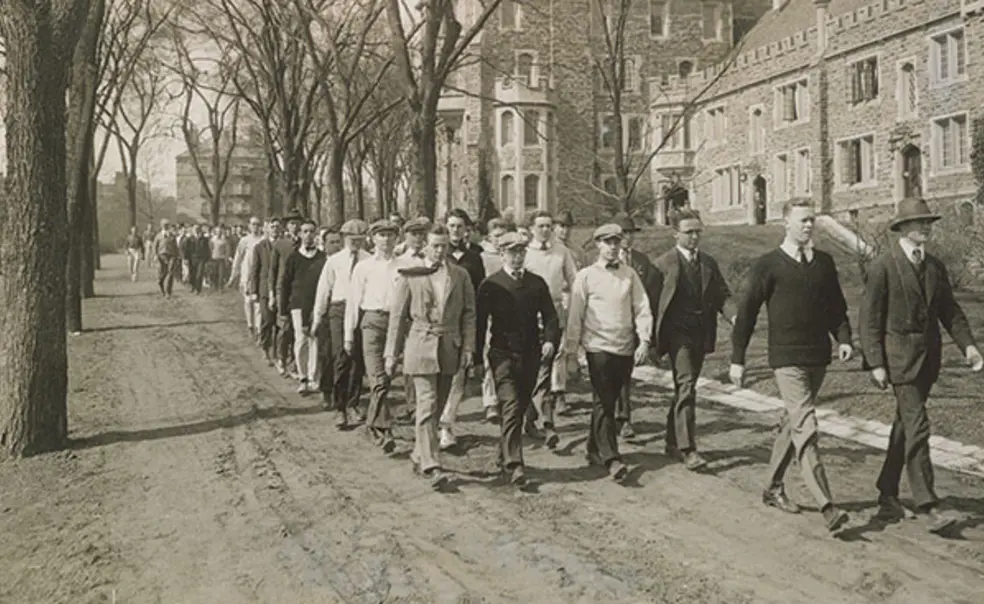The United States did not enter World War I until April 6, 1917, but at the beginning of February, as President Woodrow Wilson 1879 severed diplomatic ties with Germany, Princeton girded itself for battle.
On Feb. 9, in The Daily Princetonian, Professor of International Law Philip Marshall Brown called for a more aggressive response to the “terrific menace” posed by Germany. After deploring “the deportation of Belgians and Armenians, the use of liquid fire, poisonous gases, the bombardment of crowded cities by Zeppelins, the sinking of passenger ships without warning,” he averred that “further delay can only mean the paralyzation of our wills, the decay of American manhood, the base denial of the solemn obligations of honor.”
The University gave substance to this rhetoric by organizing the Princeton Provisional Battalion under the direction of Army Capt. Stuart Heintzelman, who had joined the faculty in the fall of 1916 as professor of military science and tactics. In the words of President John Grier Hibben 1882 *1893, “It may not be necessary for American citizens to engage in war in the near future, but Princeton should not delay in affording facilities for its undergraduates to prepare themselves for it.”
Students reacted with enthusiasm. In the first six-hour enlistment period, 509 men committed themselves “to drill one hour a day in open and close formations.” And on Feb. 26, when daily drills commenced in the gymnasium, 850 men showed up, representing 60 percent of the undergraduate student body.
What was deemed good for Princeton was deemed good for the country. With Hibben’s blessing, undergraduates circulated a petition urging Congress to “enact immediately legislation establishing in the United States a system of compulsory universal military training.”
In this environment, dissent was unwelcome, as two students learned when they sought to air “the pacifist point of view.” Hibben denied them permission to meet on campus, arguing that the “University was already committed to a war policy,” beating Congress to the punch.
John S. Weeren is founding director of Princeton Writes and a former assistant University archivist.












3 Responses
Geoff Stephens ’84
7 Years AgoPreparing for War
Thank you for the photo and story about student enthusiasm for serving in World War I (That Was Then, Feb. 7). My grandfather Elias Wolf 1920 was one of those Princetonians swept up in war fever. Despite being descended from Germans (albeit German Jews), and despite being a very nonviolent, happy-go-lucky person, he became so fanatic about killing Germans that he convinced his reluctant parents to let him drop out of Princeton and sign up for war. As he told the story, it was a cautionary tale: If someone like him could get so swept up in propaganda, anyone could. It’s a lesson I’ve carried with me my whole life. Fortunately for his descendants, the war ended just as he was about to be shipped out. He had no doubt that had he gone to war, his enthusiasm would have carried him first over the trench, and I wouldn’t be here.
Norman Ravitch *62
7 Years AgoYou can blame everything on...
You can blame everything on Woodrow Wilson. Princetonians have a special responsibility to blame this president, one of the worst. Before Wilson, presidents would go to war for material things. After him, they would go to war for ideologies. That could only come from a man who thought he was Jesus Christ -- that is, when he didn't think he was just a plain sinner in the hands of his awfully angry God. William Bullitt, with a little help from Uncle Sigmund, got it all right in his book around 1930. Much ridiculed, it still tells us more about Wilson than scores of craven historians and politicians.
Sara Logue
7 Years AgoFor more information on...
For more information on Princeton and war, feel free to check out the Seeley G. Mudd Manuscript Library's exhibition "Learning to Fight, Fighting to Learn: Education in Times of War" currently on display through June 2018. We are open to the public Monday-Friday from 9am-4:45pm. More information can be found on our blog: blogs.princeton.edu/mudd/2017/11/2017-2018-exhibition-learning-to-fight-fighting-to-learn/